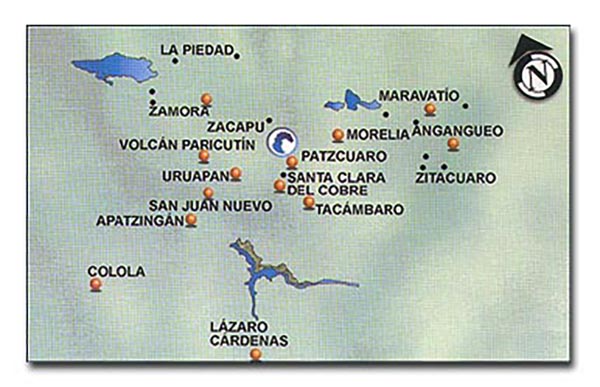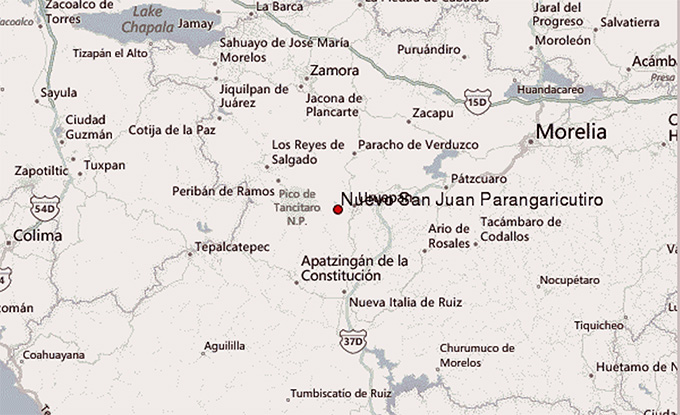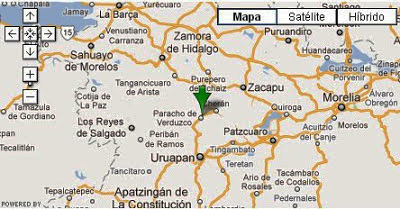Michoacan and Teotihuacan
Cuitzeo: Ex-Convento de Santa Maria Magdalena; Zona Arqueológica Tres Cerritos Zirahuen: Lago de Zirahuen; Zona Arqueológica de Tingambato Uruapan: Barranca del Cupatitzio; Cascada de la Tzararacua, Vieja Iglesia de San Juan Parangaicutiro ; Paracho (guitarras) Zamora: Santuario Guadalupano, Lago de Cuamécuaro |
Distancias:
Morelia-Pátzcuaro: 52 km
Pátzcuaro-Uruapan: 58 km
Cuitzeo: Ex-Convento de Santa Maria Magdalena
We had heard a lot about the former Santa Maria Magdalena Convent but that's nothing compared to actually standing in awe before it. Without a doubt its facade is one of the foremost jewels of colonial-era plateresque art and the indigenous touch is easily noticed in its design. What is now an entryway to the cloister once served as an open chapel and to one side bears a magnificent mural depicting the final judgment. The convent is one of the best-conserved in the country and the state of preservation of its frescos is worthy of admiration; they depict biblical scenes and make references to monastic life. The second-floor chapter house is a space where you'll easily lose yourself to the level of detail in its motifs. We continued down its halls and found monks' cells where tranquility still reins king.
We headed to Restaurante La Cabaña del Lago to enjoy some of the plates given up by the waters of Cuitzeo Lake. The most traditional are fried charales (a type of plant growing in the lake), frog legs, and mojarra al mojo de ajo (mojarra with a garlic sauce).
Back in town we had the opportunity to meet the father-and-son team of Juan and Jose Luis Carriceño. They work in the manual production of huaraches (a pre-Columbian type of sandal), a traditional Cuitzeo product. The pair kindly showed us into their house and taught us a little bit about their work. Right afterwards we went to the Nancy Artisanal Bakery where the Mascote family has produced pan corriente (traditional bread) for over four generations using an original regional recipe composed only of water, salt, and flour. There we found out that the process isn't easy and involves kneading the dough for hours and hours. The results are well worth the effort: the bread has an incomparable flavor and texture.
Heading back home from Huadacareo we passed by Cuitzeo and before continuing onward stopped to try the traditional ice cream (nieve); one of the best was the dried fruit kind. The modest but traditional Nieves Artesanales Rincon is at the end of Calle Lazaro Cardenas just before the highway to Morelia.
Cuitzeo: Zona Arqueologica Tres Cerritos
Tres Cerritos fue un importante Centro ceremonial de la cultura purépecha por lo menos hasta trescientos años antes de la colonia. Se cree que es un sitio donde se adoradaba a los antepasados, esto dicen los estudiosos por la arquitectura funeraria.
Se cree que el lugar era importante y que tenía relación con la cultura teotihuacana ya que sean encontrado objetos de cerámica de esta cultura.
Hoy el espacio lo ocupan tres estructuras, las cuales forman parte de un conjunto arquitectónico compuesto por un basamento para templo, plataforma, plazas y adoratorios.
Se toma la carretera Federal Núm. 43 (Morelia ~ Cuitzeo ~ Salamanca) en dirección norte, y al pasar el puente que cruza el Lago de Cuitzeo, se debe virar hacia el oriente sobre el camino que conduce a los poblados de San Agustín del Pulque y Mariano Escobedo. Después de tres kilómetros debes desviarte hacia el norte para tomar un camino de terracería que dirige hasta la entrada del sitio arqueológico, situada a una distancia aproximada de 500 metros.
Hotel Casa del Refugio es una hermosa propiedad de estilo colonial localizado en el centro histórico de Pátzcuaro. Ubicado en una casa que data del siglo XVIII, el hotel se encuentra en frente de la Plaza Gertrudis Bocanegra y a sólo una cuadra de la plaza principal Don Vasco de Quiroga, y a 55 km de la ciudad de Morelia.
Lago de Zirahuén
El lago de Zirahuén es un pequeño lago endorreico en el municipio de Salvador Escalante, en el estado mexicano de Michoacán. Se localiza cerca de la Carretera Federal 14D; en línea recta, unos 30 km al este de Uruapan y 15 km al suroeste de Pátzcuaro. Toma su nombre del poblado de Zirahuén, que se encuentra en la ribera norte del lago.
El lago de Zirahuén se ubica dentro de lo que se denomina Subprovincia Neovolcánica Tarasca o Corredor Tarasco, un segmento del Eje Neovolcánico de México en el que también se localizan los lagos de Pátzcuaro y Cuitzeo. En mayor medida, pertenece a la región hidrológica del río Balsas. Se trata de un lago de origen vulcano-tectónico, joven, relativamente profundo para su extensión.
Al tratarse de una cuenca endorreica, el lago de Zirahuén es hogar de varias especies endémicas, entre las que destacan el pez Allotoca meeki (tiro de Zirahuén), al igual que varios tipos de cianobacterias.
Al encontrarse en un valle aislado, rodeado de un denso bosque de pino-encino, una de las principales actividades económicas es el turismo. En años recientes han proliferado las cabañas rústicas que acogen a visitantes en busca de tranquilidad.

Zona Arqueológica de Tingambato
Tingambato is a municipality in the north-central part of the Mexican state of Michoacán. Its municipal seat is the city of the same name. The municipality has an area of 188.77 square kilometres (0.32% of the surface of the state) and is bordered by the north by the municipalities of Nahuatzén and Erongarícuaro, to the east by Pátzcuaro and Salvador Escalante, to the south by Ziracuaretiro, and to the west by Uruapan. The municipality had a population of 12,630 inhabitants according to the 2005 census. Its municipal seat is the city of the same name.
The word Tingambato is of Chichimeca origin and it means "Hill of mild climate". The story of the region can be traced 1,300 years to the arrival of the Purépecha monarchy to the region.
The site had two period of construction. In AD 450-600 ceremonial buildings with Teotihuacan-style taluds were built. In the second stage (AD 600-950) a ball court was also built in the Teotihuacan style. One tomb contains 6 men who provide evidence of dental mutilation.

Uruapan: Barranca del Cupatitzio National Park
Barranca del Cupatitzio National Park is a protected area in the Mexican state of Michoacán, centered in the headwaters of the Cupatitzio River. The river begins as a spring, which then carves a small ravine as the water begins to flow. The river is then fed by various small streams and springs, with water falling down the sides of the ravine to form small waterfalls. The park is located in the northwest part of Uruapan, surrounded by urbanization. Inside, the ground is soft and wet, with broad-leafed plants, contains various walking paths near the river for visitors, as well as a number of natural fountains built on the sides of the ravine to take advantage of natural water flows. The park is very popular, attracting tens of thousands of visitors each year.
The park is centered on a ravine formed by the emergence of the Cupatitzio River, whose name means ~river that sings~ in Purépecha. This area has soft wet ground, a temperate climate and its flora is mainly broad-leafed plants. The river begins here as a natural convergence of a number of small streams and springs, and the water here is clean. The water falling down the sides of the ravine create small natural waterfalls or are taken advantage of to create natural fountains, which makes the park unique in Mexico. Notable waterfalls include Camelina, la Yerbabuena and El Golgota. Fountains include La Copa de Oro, Cutzi ~ La Luna-, Arcoiris, Velo de Novia and Janintzizic.
The best known spring is at the very beginning of the river, called La Rodilla del Diablo (Devil's Knee), named after a small indentation in the rock next to the pool formed by the spring. According to local myth, the indentation was formed by the Devil falling to his knees, but there are competing versions as to why he did. The first states that he was forced to his knees by a crucifix held by Juan de San Miguel, the Franciscan monk who founded modern Uruapan. Another version of the story states that the impression was may by the knee when the Devil tripped and fell fleeing from the same person.
There are a number of stone bridges to allow visitors to cross back and forth between the two banks, with names such as Los Recién Casados and Los Enamorados.[6] The area also contains a mural named "Eréndira" by local artist Manuel Pérez Coronado, which is badly deteriorated.

Uruapan: Cascada de la Tzaráracua
La Cascada de la Tzaráracua se encuentra a unos 10 kilómetros de Uruapan, en el estado mexicano de Michoacán.
La cascada tiene una altura aproximada de 40 metros y se forma por el río Cupatitzio, el cual nace en el parque natural de Barranca del Cupatitzio, dentro de la ciudad de Uruapan. Este río es afluente del río Tepacaltepec. El recorrido se extiende en más de 3 kilómetros de escaleras y caminos con pendientes del 5 al 20%, a mitad del recorrido los escarpados taludes de roca ofrecen un panorama general del bosque circundante, durante los meses de lluvia (julio a octubre) la cascada se despierta entre la bruma y niebla en las faldas de los cerros, por doquier se ven los escurrimientos de agua que se filtra entre las rocas y se cuela en el follaje de los árboles, las ardillas y otros mamíferos abundan en los primeros 500 metros del descenso a la cascada y las orquídeas en floración destacan entre el colorido follaje de los encinos.
Para llegar a la cascada existen dos opciones, la primera es tomar el camino lateral para bajar a caballo (se renta en $100.00 pesos ida y vuelta) en cuyo caso el recorrido toma alrededor de 25 minutos. La segunda opción es descender a pie por el andador peatonal y bajar las 579 escaleras entre impresionantes taludes de roca volcánica, en donde también puede practicarse el rappel, las áreas para acampar son las explanadas cercanas a los miradores en los cuales existen asadores, sanitarios, leña y un techo donde guarecerse de la lluvia.
El recorrido puede ampliarse otros 20 minutos de caminata hasta llegar a la Tzararacuita que se mantiene como uno de los más hermosos sitios naturales, su cascada contiene cristalinas aguas donde se puede disfrutar de un refrescante chapuzón, después del calor de la caminata.
El área comprende más de 45 hectáreas de bosque pino encino y mesófilo de montaña, la temperatura es agradable, aunque durante la fecha de estiaje es recomendable llevar suficiente agua durante el trayecto.
A la Tzararacuita se puede llegar desde Jucutacato por un camino de terracería en el que se puede ingresar en un vehículo 4x4 y que lleva directamente hasta la parte más alta de la Tzaráracua, donde puede apreciarse la cascada principal y el fondo de más de 120 metros de altura.
San Juan Parangaricutiro
Nuevo San Juan Parangaricutiro, in the Mexican state of Michoacán, is a small village near the Parícutin volcano. The city is called "Nuevo" because the original San Juan Parangaricutiro was destroyed during the formation of the Parícutin volcano in 1943. Along with the village of Parícutin, San Juan Parangaricutiro was buried beneath ash and lava. The tops of cathedrals in old San Juan Parangaricutiro still protrude from the volcanic deposits.
Nuevo San Juan Parangaricutiro is located about 8 km west of Uruapan and 16 km east of the peak of Parícutin in central Michoacán.

Today, the original San Juan Parangaricutiro church still stands, halfway buried in solidified lava rock, with the massive cinder cone of Parícutin looming in the background. It is all that remains of the village. Climbing over the volcanic rock to see the church that survived the catastrophe has become a tourist experience, and a major source of revenue for the region.

Paracho
Paracho de Verduzco (often called merely Paracho) is a small city located in Michoacán, Mexico. Located at 19°39'0"N 102°4'0"W, about 100 kilometers (62 miles) west of s tate capital Morelia, it serves as the municipal seat for the surrounding municipality of Paracho. It has a population of some 16,500.
Paracho is well known throughout both Mexico and elsewhere in the world as hub of lutherie. This is because they are reputed to make the best sounding guitars and vihuelas in all of Mexico. The town is full of music shops that sell handmade stringed instruments. Some instruments that can be found in Paracho are: 10-string mandolins, armadillo-backed guitars (concheros) and mandolins, and acoustic bass guitars, as well as regular classical guitars and mandolins, bajo sextos, vihuelas guitarrons and many others. Many of the stores and workshops allow visitors to watch the guitar-making process directly.

Zamora: Santuario Guadalupano
El Santuario Diocesano de Nuestra Señora de Guadalupe o Santuario Guadalupano es un santuario católico mariano dedicado a la Virgen de Guadalupe, ubicado en la ciudad mexicana de Zamora de Hidalgo en el estado de Michoacán de Ocampo, México. El Santuario Guadalupano es considerado como el recinto religioso con las torres más altas de México, (107,5 m). El 2 de febrero de 1998 cumplió un centenario de existencia y su inauguración fue el 12 de diciembre de 2008. El recinto es representativo del nuevo orden neogótico que llegó a México en la segunda mitad del siglo XIX y será considerado como nueva catedral de la Diócesis de Zamora Michoacán.
- Considerado entre los 15 recintos religiosos más grandes del mundo en cuanto a superficie, donde ocupa el 14° lugar.
- Considerado entre las nueve catedrales neogóticas más grandes del mundo.
- Es la sexta iglesia más alta en el continente americano, después de la Catedral de Maringá en Brasil (124 m), la Riverside Church en Nueva York (119 m), la Basílica del Voto Nacional en Ecuador (115 m), la Catedral Basílica Nuestra Señora del Rosario de Manizales en Colombia (113 m) y la Catedral de La Plata en Argentina (112 m).
- Es la quinta más alta del continente americano si solo tomamos en cuenta las de culto católico; ya que, la Riverside Church en Nueva York es bautista. También es la quinta más alta si tomamos en cuenta las que se encuentran en Latino América.
- Es la cuarta iglesia más grande en superficie (m2) en el continente americano con sus 5.414,58 m2, después de San Juan El Divino en Nueva York con 11.240 m2, La Basílica Nueva de Guadalupe en la Ciudad de México con 8,147 m2 y San Pedro y San Pablo en Washington con 7.711,91 m2.
- Considerado el templo con las torres más altas de México, con sus 107,5 m de altura.
- Es el recinto religioso de estilo neogótico más grande de México.
- Es el santuario dedicado a la Virgen de Guadalupe neogótico más grande del mundo.

Zamora: Lago de Cuamécuaro
Ubicado en el municipio de Tangancícuaro, este Parque Nacional consta de casi 10 hectáreas de área protegida, incluido el lago que se abastece de manantiales naturales. Su agua cristalina y abundante vegetación ofrecen un paisaje natural maravilloso haciéndolo el lugar ideal para escaparse un día. Dentro del parque también se encuentran albercas de aguas termales aunque si prefieres disfrutar del lago, puedes dar en él un paseo en lancha.







